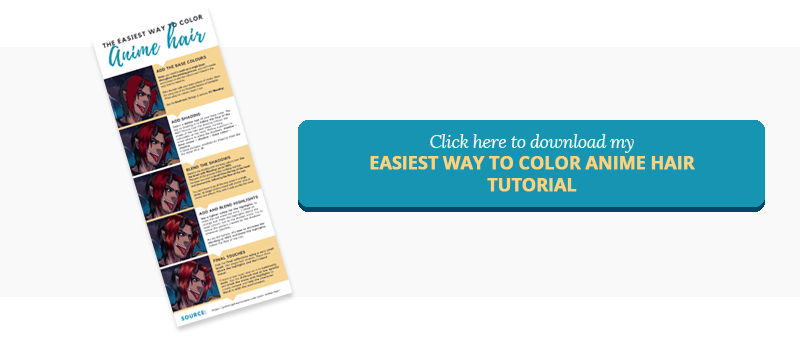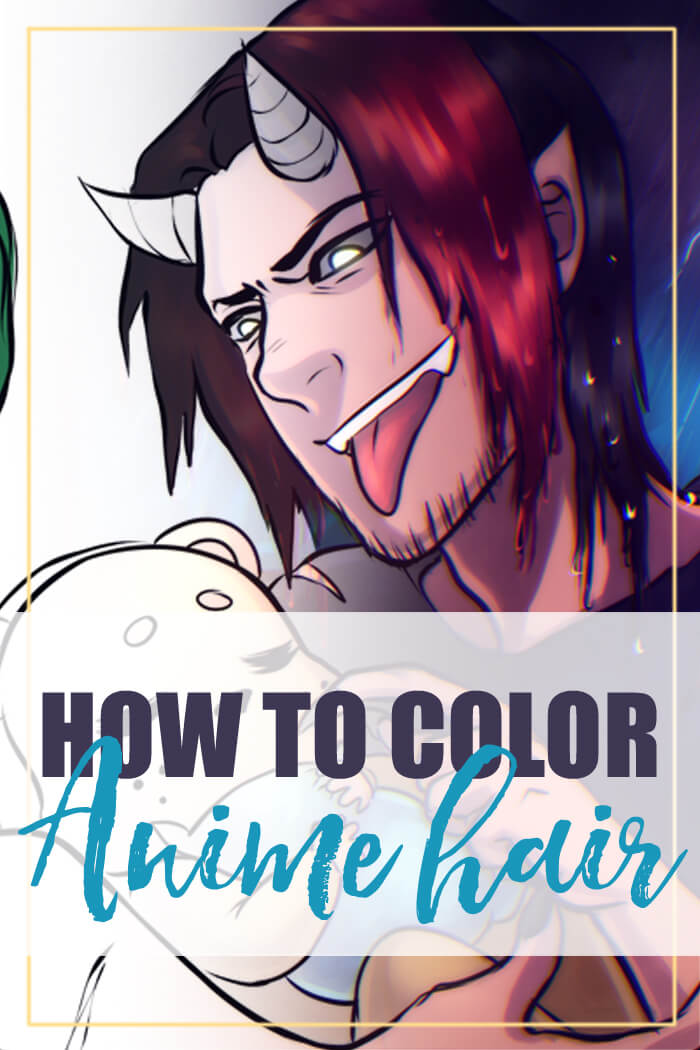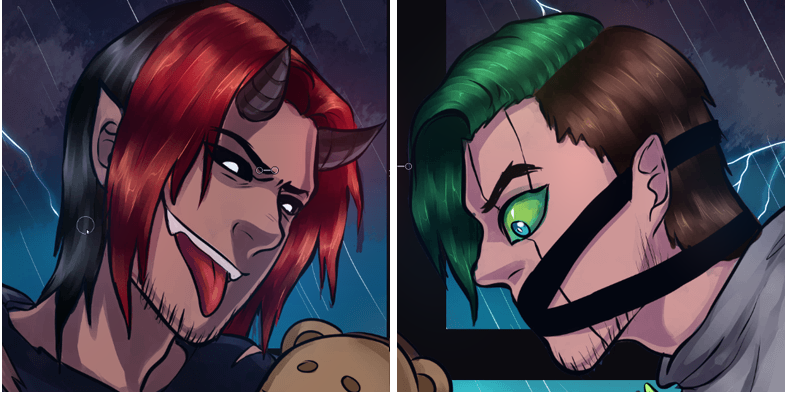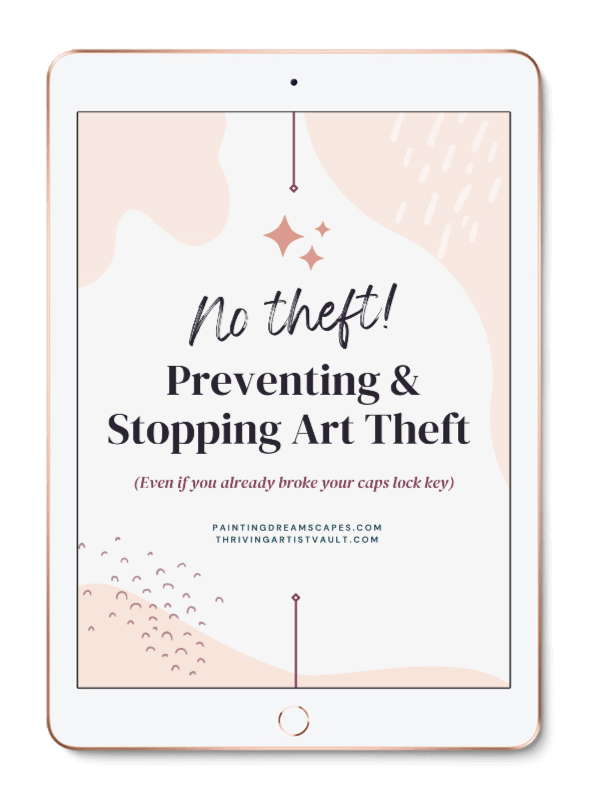After 10 years of being an artist and learning how to draw, there’s one thing I know for sure: drawing and coloring anime hair is one of the best parts of any project! Well, I probably love painting landscape backgrounds a little bit more, but coloring hair is a close second! It’s been over a year since I developed this technique to color anime hair and not only does it look really good, it also saves me a lot of time compared to my other techniques! So, today I want to show you how to color anime hair using Paint Tool SAI!
It’s a very simple, easy and quick technique to color anime hair and I want you to master it! A video tutorial on this same process will be available soon!
Note: this technique may be applied for other programs but it was specially developed for Paint Tool SAI, using the tools included in this program. You’ll need to find the equivalent tools for your program of choice.
STEP 1 – ADDING BASE COLORS
Note: you need to work on a single layer throughout the painting process, you can’t create extra layers or else the colors won’t blend in the way they’re meant to. Don’t worry, it’s a very easy anime painting technique! You only need to make sure you don’t go out of the lines OR that the hair layer is blocked to prevent you from colouring out of the base layer.
This should be an easy and straightforward step! Fill in the hair with your base colour(s) of choice. Since I’m using one of my favourite fanarts of Darkiplier and Antisepticeye, I’ll be using their official colors: black + red & green + brown.
STEP 2 – ADDING THE FIRST LAYER OF SHADING
Now that the base colors are set, it’s time to have fun!
Before we begin, I have a few tips for you:
- This may go against your instinct but… Whenever possible, make sure to paint the background of your image first. Why? Simple: it will help you know where the light source is and you will be able to adapt the colors to match the ambient light in the piece.
For example, in this piece, it’s a stormy night in a softly lit bedroom. Therefore, the colors aren’t as bright and vivid as they would if they were at the beach in a sunny day. Also, since the background has a lot of blues and purples, adding these colors to the overall shading will help the characters feel like they belong in that setting, rather than look like they were copy-pasted in it. - Set your light source from the start! Think of where you want the light source to be and shade your piece accordingly. If each shade points to a different direction, it will break your piece. Know where the light source is and place the shadows in the places that light doesn’t reach.
Tool: Brush
Settings: Min Size 0% | Density 100% | Shape Stringy_L (simple circle is the default, use it only if you don’t have Stringy_L) | Blending, Dilution and Persistence 8%
Let’s get painting! Select a darker hue of your base color for this. To make it look more interesting, I didn’t pick pure dark red. Instead, I used a dark red with a slight tint of pink to give it a purplish feel (re: tip #1!). That helps bring out the hue in the base color. For the green, I opted for a darker green with a blueish tint to it. You can do this through the color wheel.
The most important thing in this step is that you follow the flow of the hair! Notice how the shading follows the shape of the hair and head, curving noticeably at the roots. Follow a pattern to know where to place the shadows: shadow – base colour – shadow – base colour – shadow. Repeat that combination throughout the hair.
Notice how each section of shading goes up and down, almost resembling an M or W letter? Doing that helps the shading look more dynamic and realistic.
STEP 3 – BLENDING THE FIRST LAYER OF SHADING
Tool: Brush
Settings: Min Size 0% | Density 100% | Shape Stringy_L (simple circle is the default, use it only if you don’t have Stringy_L) | Blending 100% | Dilution and Persistence 8%
We’re going to blend in the shading with the base colors now. We do this by changing the “Blending” settings of the brush from 8% to 100%. Increasing this to 100% makes the brush unable to paint anything new, it can only merge and blend in the existing colors in the layer.
I like to say this part of the process is like combing real hair, because you want to brush from the top of the head and downwards, following the shape of the hair. You don’t have to go all the way down in a single combing stroke, feel free to do longer strokes mixed with shorter ones to create nice effects. Play with it until you like the result.

STEP 4 – FIFTY SHADES DARKER
Tool: Brush
Settings: Min Size 0% | Density 100% | Shape Stringy_L (simple circle is the default, use it only if you don’t have Stringy_L) | Blending 8% –> 100% | Dilution and Persistence 8%
Please, don’t kill me for the pun! I couldn’t help myself! This step mostly repeats the shading and blending steps we already covered, but this time we’re going to use darker shades (do you get the pun now? No? Okay 🙁 ). Sometimes this step won’t be necessary, but I usually do it to make the hair look shinier by darkening certain parts. So, like I said, pick a darker colour and repeat the shading in the same areas until the contrast is nice. Remember to set the ‘Blending’ setting of the brush to 8% to paint the shadows and to increase it to 100% to blend them.
The image below shows how it looks once the second, darker layer of shading has been blended! Looking good!
STEP 5 – ADDING HIGHLIGHTS
Tool: Brush
Settings: Min Size 0% | Density 100% | Shape Stringy_L (simple circle is the default, use it only if you don’t have Stringy_L) | Blending 8% | Dilution and Persistence 8%
You’re doing a great job, friend, keep it up! Soon you’ll be able to color anime hair like a pro 🙂
It’s time to add the highlights to our awesome anime hair! Let’s do this! Select the brush tool, set the ‘Blending’ to 8% and reduce the size of the brush, the highlights will be thinner than the shadows. Paint the highlights above the base colors, not on the shaded areas. Try to follow the pattern created by the shadows whenever possible.
As we did before, it’s time to increase the blending to 100% and blend the highlights. Follow the flow of the hair.
Repeat the process to make the highlights more noticeable! Use thinner strands now! Remember to add them at the top of the head, near the roots of the hair. Don’t forget to blend them after you’ve painted them.
Notice: sometimes, depending on the colors you’re using, adding extra highlights won’t be necessary. For instance, I had to do a few rounds of highlight for Markiplier’s red hair, but Jacksepticeye’s green hair only needed one. Add more highlights as you see fit!
STEP 6 – ADDING FINAL REFLECTIONS
Tool: Brush
Settings: Min Size 0% | Density 100% | Shape Stringy_L (simple circle is the default, use it only if you don’t have Stringy_L) | Blending 8% | Dilution and Persistence 8%
Now that the highlights are done, it’s time to add the final reflections in that pretty hair! For this you’ll need to use a very small brush, the reflections need to be very thin, almost like single hair strands. Place them above the highlights you created in the previous step. You don’t need to blend these!

BONUS STEP: ADD LIGHTING EFFECTS
Tool: Airbrush
Settings: Min Size 100% | Density 20% | Blending 8%
Create a new layer and set it to Luminosity mode (it’s called “Addition” in some SAI versions!). Use the Airbrush tool at low opacity and brush the areas with highlights to bring them out more and strenthen the sense of volume. Use the colour of each section for this step! To make the characters blend in with the background and not look copypasted into it, I used blue and purple in the dark areas of the hair and skin using the airbrush tool on the layer we set to Luminosity.
CONGRATS! YOU DID IT! YOU CAN NOW COLOR ANIME HAIR LIKE A PRO!
We’ll repeat the whole process for the other part of the hair (black for Markiplier and brown for Jacksepticeye). So, let’s recap!
ADDING THE FIRST LAYER OF SHADING
BLENDING THE FIRST LAYER OF SHADING
Since we already used pretty dark colors for the initial shading, there’s no need to add darker shadows again. So, we’re skipping that step!
ADDING HIGHLIGHTS
BLENDING HIGHLIGHTS
ADDING MORE HIGHLIGHTS
BLENDING HIGHLIGHTS AND ADDING FINAL REFLECTIONS
Woohoo! You made it, friend! Told you it was an easy anime painting technique! You’re now ready to color anime hair using this technique and make it look appealing! If you try it let me know how it went!
I’ll be reading your comments, let me know if you have any question or need clarification!
























This helped a lot! And it really doesn’t take too long, thank you 😀
I’m so happy to hear that, Danya! Let me know if you have suggestions for future tutorials or posts you’d like to read!